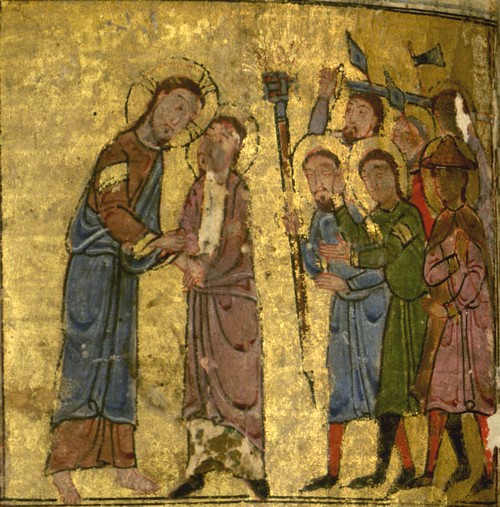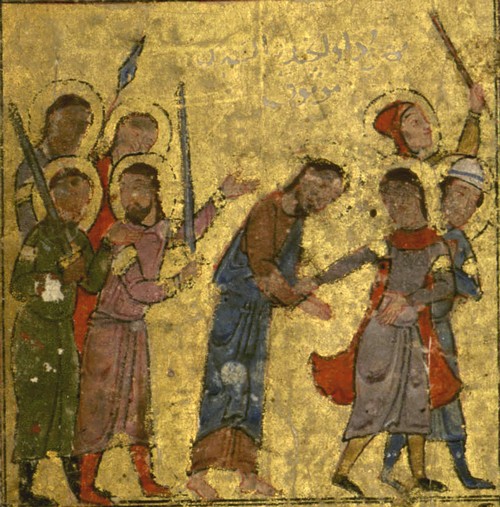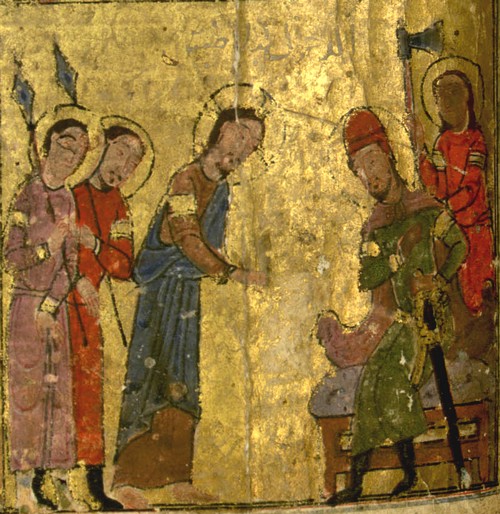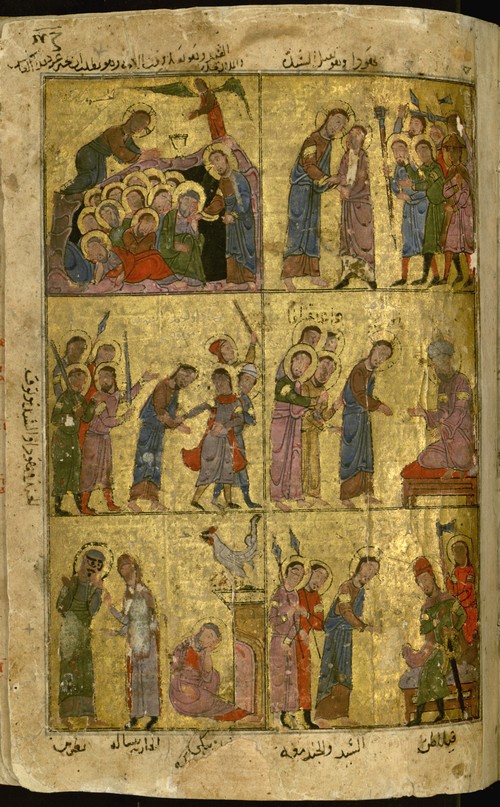
Try Amazon Audible Plus
Coptic-Arabic Gospel
Institut Catholique Ms. Copte-Arabe 1, 1249-50 AD.
Folio 56v. : 7th illumination of the Gospel of Matthew
Betrayal by Judas



La Trahison de Judas
A gauche le Christ recevant le baiser de Judas. En face à droite, un groupe de soldats, tenant des torches ou des piques.
Inscription arabe (voir ill. pleine page) : Judas embrassant le Seigneur.
The Betrayal of Judas
To the left Christ receives the kiss of Judas. To the right, a group of soldiers, holding torches or pikes.
Arabic inscription (see Fig full page.) Judas kisses the Lord.

Le Christ captif
Le Christ conduit par trois soldats se dirigeant vers la droite. Derrière, quatre autres portent des épées.
Inscription arabe (voir ill. pleine page) : les soldats et Judas et le Christ enchaîné.
Christ captive
Christ lead by three soldiers heading to the right. Behind four others carry swords.
Arabic inscription (see Fig full page.) The soldiers and Judas and Christ in chains

Condamnation du Christ par Pilate
Pilate est à droite, assis sur un tabouret garni d’un coussin, tenant une épée noire appuyée à terre. Le Christ lui fait face, les mains liées. Comme dans les autres illustrations, les soldats sont représentés chaussés, tandis que le Christ a les pieds nus.
Inscription arabe (voir ill. pleine page) : Pilate. Le Seigneur et les soldats avec lui.
Condemnation of Christ by Pilate
Pilate is at right, sitting on a stool topped with a cushion, holding a black sword pressed to the ground. Christ facing it, his hands tied. As in other illustrations, soldiers are represented shod, while Christ is barefoot.
Arabic inscription (see Fig full page.) Pilate. The Lord and the soldiers with him.

Referenced in The military technology of classical Islam by D Nicolle
172A to 172C. Manuscript, A - Beheading of the Baptist, B - Massacre of the Innocents, C - Centurion at Capernaum, Gospel, 1249-50 AD, Coptic, Institut Catholique Ms. Copte-Arabe 1, ff. 4v and 18v, Paris (Ler C).
p83 Vol. 1 There are many illustrations of a great variety of war-axes to be found in Muslim and neighbouring art from this period. Some are almost of the "half moon" nāchakh type while others have blades with very narrow cutting edges, perhaps designed to penetrate mail or lamellar. Most have long hafts and there is no very obvious difference between the weapons of infantry and those of cavalry, between ṭabar and ṭabarzīn if these are indeed the axes in question (Figs. 172, 177G, 247, 249, 250, 289, 294, 305, 394, 604G, 605 and 606).
Folio 4v, The Magi before Herod; The Massacre of the Innocents and Christ and the Centurion of Capernaum, Coptic-Arabic Gospel. Institut Catholique Ms. Copte-Arabe 1
Folio 18v, Beheading of John the Baptist, Coptic-Arabic Gospel. Institut Catholique Ms. Copte-Arabe 1